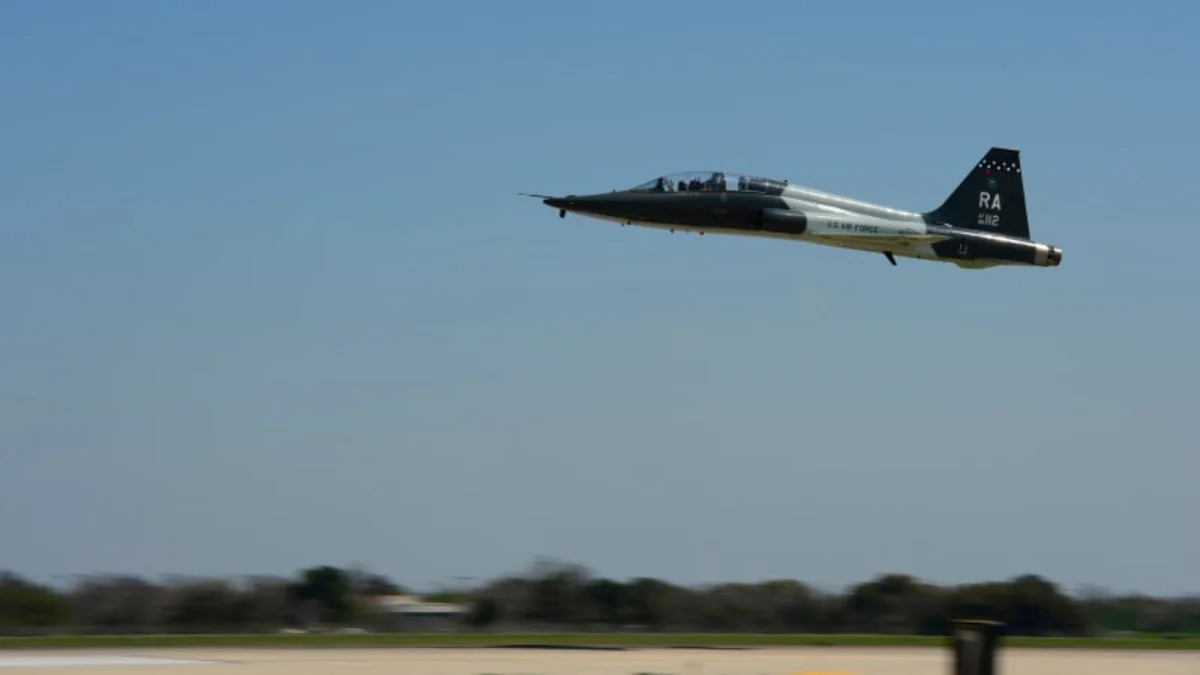The US Air Force is among the most advanced on the planet. The F-35 and F-22 are at the bleeding edge of development, and even older so-called "legacy" fighters, like the F/A-18 Super Hornet, are supremely capable in battle. But with such an impressive arsenal of fighters, the US Air Force is training new pilots on a jet that first flew in 1959.
That jet, the T-38 Talon, has been on the radar for years. But the Air Force has routinely pushed its replacement, the T-X, back. The Air Force first started considering the program's objectives in 2003, but a full statement of requirements didn't come until March of last year. With a formal request for proposals not due until the end of this year, the T-38's replacement isn't due until 2024. That's a big problem.
"Reliance on essentially an obsolete aircraft creates a maintenance nightmare, risks a catastrophic fleet failure that would halt all jet pilot training, and creates a potential skills gap as new pilots move to highly sophisticated aircraft such as the F-22 and F-35," writes Dr. Daniel Gouré of the Lexington Institute, a Virginia-based conservative think tank, writes.
Part of the delay is because the Air Force can't figure out what the heck the T-X is supposed to be. Is it a "non-developmental item?" A clean-sheet design? According to the Lexington Institute, the USAF may even want to develop an A-10 Warthog replacement from its new trainer. In general, it sounds like the many voices within the service aren't sure of what the T-38's successor should be. But there are bigger problems with the Air Force's approach to replacement trainers.
"As any observer of the defense acquisition system knows, there are real dangers associated with unstable and ever increasing requirements. Costs go up, development times lengthen, risk increases and testing takes longer," Gouré writes. "The tendency with these one-every-half-century acquisition programs is to load them down with the requirement to respond to everything that might possibly be needed over the next 50 years. Such an approach is guaranteed to fail in the future as it has so often in the past."
According to Gouré, the one thing aiding the Air Force is the sheer number of companies ready to throw their hats in the ring. Raytheon and Italy's Leonardo have the Alenia Aermacchi M-346 while Lockheed Martin is teaming with Korea Aerospace Industries to modify the South Korean Air Force's T-50 trainer. Northrop Grumman is readying a brand-new design, and Boeing is teaming with Saab for its own clean-sheet approach. None of these entries are safe from further budget issues, of course.
And it's for that reason that Dr. Gouré and the Lexington Institute are calling on the Air Force to issue an RFP, stop piling on additional requirements, and award a manufacturer before beginning big defense expenditures, like the new B-21 bomber.
That jet, the T-38 Talon, has been on the radar for years. But the Air Force has routinely pushed its replacement, the T-X, back. The Air Force first started considering the program's objectives in 2003, but a full statement of requirements didn't come until March of last year. With a formal request for proposals not due until the end of this year, the T-38's replacement isn't due until 2024. That's a big problem.
"Reliance on essentially an obsolete aircraft creates a maintenance nightmare, risks a catastrophic fleet failure that would halt all jet pilot training, and creates a potential skills gap as new pilots move to highly sophisticated aircraft such as the F-22 and F-35," writes Dr. Daniel Gouré of the Lexington Institute, a Virginia-based conservative think tank, writes.
Part of the delay is because the Air Force can't figure out what the heck the T-X is supposed to be. Is it a "non-developmental item?" A clean-sheet design? According to the Lexington Institute, the USAF may even want to develop an A-10 Warthog replacement from its new trainer. In general, it sounds like the many voices within the service aren't sure of what the T-38's successor should be. But there are bigger problems with the Air Force's approach to replacement trainers.
"As any observer of the defense acquisition system knows, there are real dangers associated with unstable and ever increasing requirements. Costs go up, development times lengthen, risk increases and testing takes longer," Gouré writes. "The tendency with these one-every-half-century acquisition programs is to load them down with the requirement to respond to everything that might possibly be needed over the next 50 years. Such an approach is guaranteed to fail in the future as it has so often in the past."
According to Gouré, the one thing aiding the Air Force is the sheer number of companies ready to throw their hats in the ring. Raytheon and Italy's Leonardo have the Alenia Aermacchi M-346 while Lockheed Martin is teaming with Korea Aerospace Industries to modify the South Korean Air Force's T-50 trainer. Northrop Grumman is readying a brand-new design, and Boeing is teaming with Saab for its own clean-sheet approach. None of these entries are safe from further budget issues, of course.
And it's for that reason that Dr. Gouré and the Lexington Institute are calling on the Air Force to issue an RFP, stop piling on additional requirements, and award a manufacturer before beginning big defense expenditures, like the new B-21 bomber.


Sign in to post
Please sign in to leave a comment.
Continue